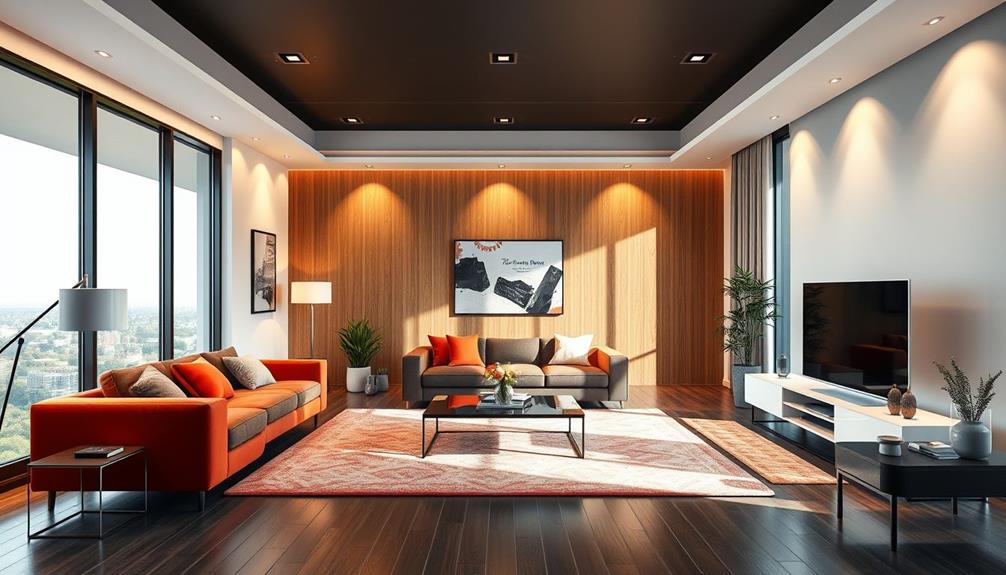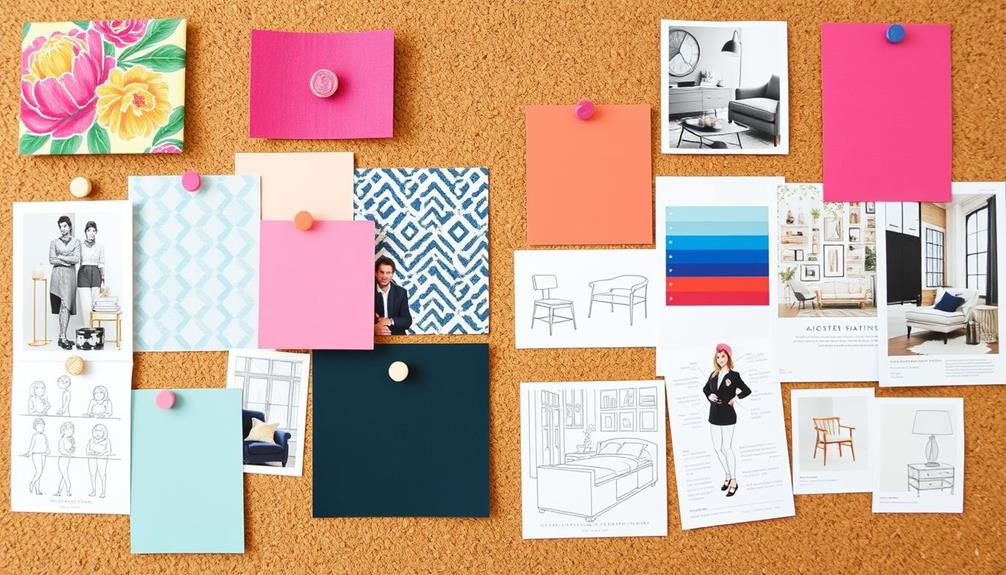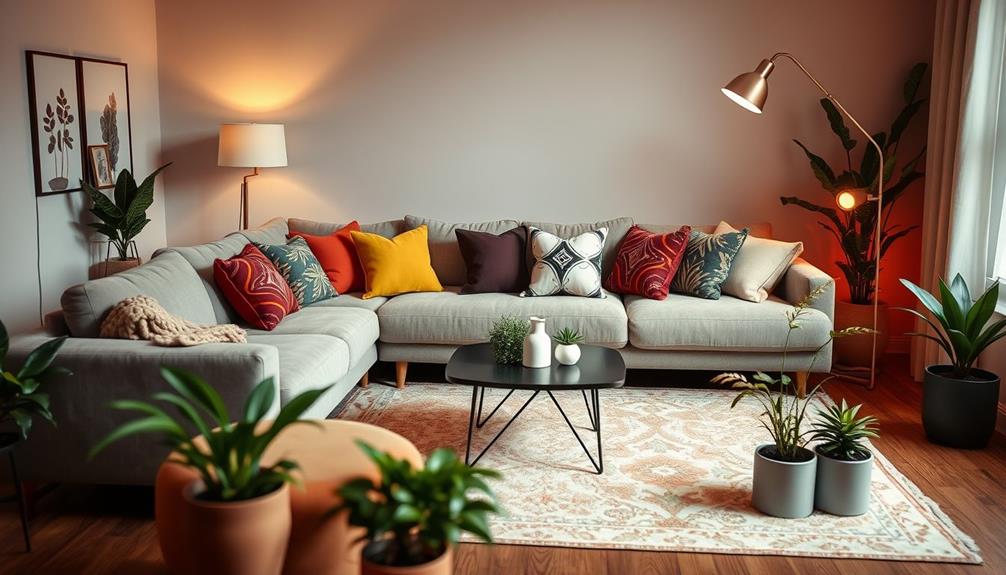To visualize interior design, start by accurately measuring your room's dimensions. Use user-friendly tools like RoomSketcher or Planner 5D to create detailed floor plans and explore 3D models for real-time visualization. Capture your designs with unique camera angles for stunning snapshots. Experiment with various design styles by creating mood boards that highlight your preferences. Don't forget to apply the 60-30-10 rule for color palettes to guarantee harmony in your space. With these techniques at your fingertips, you're already on your way. Explore further, and you'll uncover even more strategies to enhance your design journey!
Key Takeaways
- Utilize user-friendly tools like RoomSketcher and Planner 5D for creating detailed floor plans and 3D visualizations of designs.
- Experiment with various camera angles and settings in design software to capture stunning snapshots of your interior concepts.
- Create mood boards to visualize color palettes and design elements, ensuring a cohesive aesthetic throughout your space.
- Apply the 60-30-10 color rule to maintain balance, with a dominant color, secondary color, and accents for visual harmony.
- Access online courses and YouTube channels to enhance your skills in visualization techniques and stay updated on design trends.
Floor Plan Creation Techniques

Creating a floor plan is vital for transforming your vision into reality, and it all starts with accurately measuring your room dimensions. This step guarantees a precise layout, which is key for effective design implementation.
Once you've got your measurements, consider how you might incorporate elements of Mid-Century Modern Design to add a nostalgic yet contemporary touch to your space. It's time to engage in your interior design project by using user-friendly design tools like the RoomSketcher App. With its drag-and-drop functionality for walls, windows, and doors, you'll find creating a floor plan intuitive and efficient.
As you design, take advantage of the library that offers over 7,000 fixtures, finishes, and furniture items. This access allows you to enhance the realism and detail of your floor plan, making it truly reflective of your style.
One of the standout features is the ability to generate a stunning 3D interior design model while you draw. This feature lets you visualize your interior design in real-time, allowing you to see how different elements interact within the space.
Experimenting with various layouts and configurations is vital. This flexibility helps you discover the most functional and aesthetically pleasing arrangement for your project, bringing your design dreams to life.
Utilizing 3D Visualization Tools

When you immerse yourself in interior design, utilizing 3D visualization tools can greatly elevate your project. Programs like RoomSketcher and Planner 5D allow you to create stunning floor plans and visualize your designs in real-time. This enhanced capability helps you understand spatial arrangements and aesthetics better than ever before.
By generating photorealistic renderings, these tools enable you to envision the final outcome of your project, making it easier to spot potential design flaws before implementation. Many home design software applications offer drag-and-drop functionality, letting you insert walls, windows, and furniture with ease. This streamlines the design process and enhances your overall experience.
Moreover, real-time modifications in 3D visualization software facilitate instant feedback on color schemes, furniture placement, and layout. This means you can experiment creatively and make informed decisions without hassle.
Utilizing 3D visualization tools also greatly improves communication between you and your clients, as tangible visuals reduce misunderstandings and align expectations throughout the design process. By embracing these tools, you'll not only enhance your workflow but also elevate the quality of your interior design projects.
Crafting Compelling Design Snapshots

Capturing compelling design snapshots can transform how you present your interior design concepts. By utilizing the camera tool in 3D interior design software, you can create stunning design photos from various perspectives. Adjusting camera height and aperture settings allows you to find unique angles and lenses that enhance your visual storytelling.
Consider saving multiple snapshots in an image gallery to compare different design ideas effortlessly. This helps streamline the decision-making process.
Here's a simple table to visualize how different elements can interact within your design snapshots:
| Color Palette | Furniture Items | Design Style |
|---|---|---|
| Warm Neutrals | Modern Sofa | Contemporary |
| Cool Blues | Vintage Armchair | Eclectic |
| Earthy Tones | Minimalist Dining Set | Scandinavian |
Transform your favorite snapshots into high-quality 3D images to elevate client presentations, providing a professional and immersive experience. By experimenting with various color schemes and furniture styles in your snapshots, you'll effectively communicate your design vision and make a lasting impression.
Selecting Your Design Style

To find your perfect design style, start by exploring various design inspirations through websites, magazines, and social media.
As you gather ideas, pay attention to the common themes that resonate with you, like color palettes and patterns.
Don't be afraid to mix different styles; it's a great way to create a space that truly reflects your personality.
Explore Design Inspirations
Often, exploring design inspirations is one of the most exciting parts of selecting your design style. Start by diving into various design websites, magazines, and social media platforms. Look for images that resonate with your personal taste and gather a wide array of inspirations.
Consider incorporating elements from different styles, such as cozy teenage girl room colors, to add warmth and personality to your space. As you collect these visuals, create a mood board to combine different styles, colors, and textures. This will help you visually map out your preferred design elements and themes.
Next, analyze the saved images for recurring colors, styles, and patterns. This step is essential in identifying a cohesive design concept that fits your lifestyle and preferences.
Don't hesitate to mix elements from different design styles; it's a great way to create a unique aesthetic that truly reflects your personality.
Identify Personal Preferences
Understanding your personal preferences is essential when selecting a design style that truly reflects who you are. Start by gathering inspiration from interior design magazines, websites, and social media. Look for elements that resonate with your aesthetic.
As you collect images, analyze them for recurring themes, colors, and styles to help identify your personal preferences. For instance, if you're drawn to the warmth of rustic elements, consider exploring modern farmhouse decor trends that incorporate natural materials and earthy tones.
Consider your daily routines and lifestyle needs. Your design choices shouldn't only be visually appealing but also functional. If you appreciate a variety of design styles, don't hesitate to mix them; an eclectic style can lead to a unique and personalized space.
Creating a mood board can be a helpful way to visualize these elements together.
If you're feeling uncertain or overwhelmed, consulting with a professional interior designer can provide tailored guidance. They can help clarify your design style preferences, ensuring your space truly represents you.
Combine Different Styles
Combining different interior design styles can transform your space into a unique reflection of your personality. To achieve this, start by identifying key elements from each style you're drawn to, including color palettes, patterns, and textures. This careful selection will help you visualize a harmonious blend.
Analyzing saved inspiration images can be particularly helpful; look for recurring colors and styles that resonate with you. Once you've gathered your ideas, consider the 60-30-10 color rule: use a dominant color from one style on your walls, a secondary color from another on your furniture, and accent colors through decor. This approach maintains visual balance and cohesiveness.
Don't hesitate to consult with interior designers, as they can provide personalized guidance on blending styles effectively. Their expertise can help you avoid potential design clashes and guarantee that your combined styles reflect your individuality.
Color Palette Strategies

Creating a cohesive color palette is vital for achieving a harmonious interior design. One effective strategy is the 60-30-10 rule, which suggests using a dominant color for 60% of the space, a secondary color for 30%, and an accent color for 10%. This method provides balance and visual interest.
Here's a simple table to help you visualize these strategies:
| Color Role | Percentage | Examples |
|---|---|---|
| Dominant Color | 60% | Wall paint in neutral colors |
| Secondary Color | 30% | Upholstery in complementary colors |
| Accent Color | 10% | Accessories in bold tones |
Incorporating neutral colors as your base allows for flexibility with seasonal bolder accents. When choosing colors, consider using a color wheel to find complementary colors, enhancing your design's vibrancy. Also, always test paint samples under different lighting conditions, as natural and artificial light can dramatically affect color perception. Finally, keep an eye on current color trends from sources like Pantone to verify your choices are fresh and appealing.
Learning Resources for Designers

To boost your interior design skills, check out online courses that cover everything from basics to advanced techniques.
YouTube channels like "Mr. Kate" and "House & Home" are fantastic for practical tips and inspiration.
These resources can help you sharpen your design eye and stay updated on current trends.
Recommended Online Courses
Online courses provide an excellent opportunity to elevate your interior design skills and visualization techniques. Whether you're working on a home design project or looking to refine your software to create stunning visuals, there are plenty of options available online. Platforms like Skillshare and Coursera offer hands-on projects that improve your practical skills and visual comprehension.
Here's a quick overview of recommended courses:
| Platform | Course Focus | Key Features |
|---|---|---|
| Skillshare | General Interior Design | Hands-on projects |
| Udemy | Software (SketchUp, AutoCAD) | Detailed visualization techniques |
| Interior Design Institute | Extensive Diploma | Visualization strategies |
| LinkedIn Learning | Color Theory & Lighting Design | Insight into design concepts |
Top Design YouTube Channels
Immersing yourself in the world of interior design can be exciting, and YouTube offers a treasure trove of resources to help you enhance your skills. With various channels available, you'll find inspiration to transform your home and refine your design approach.
Here are a few must-watch channels:
- Mr. Kate: A mix of DIY projects and accessible interior design tips.
- House & Home: Professional advice, home tours, and renovation insights.
- Studio McGee: Tips for achieving a modern, clean aesthetic.
These channels not only showcase how your design will look and feel but also empower you to become your own Interior Designer.
You'll learn how to create stunning renderings of your spaces and implement trends that resonate with your personal style. Platforms like "The Design Network" and "DIY Creators" offer expert interviews and hands-on projects that enhance your skills.
As you explore these resources on social media, you'll discover practical insights and creative ideas that can elevate your design game.
Immerse yourself and let these YouTube channels guide you on your interior design journey!
Conclusion
In the grand world of interior design, visualizing your ideas is like wielding a magic wand—transforming empty spaces into breathtaking masterpieces! With the right floor plans, 3D tools, and a splash of color, you can create environments that will leave everyone speechless. Don't underestimate the power of a well-chosen design style; it can elevate your project from ordinary to extraordinary in the blink of an eye. So go ahead, release your creativity and watch your visions come to life!









